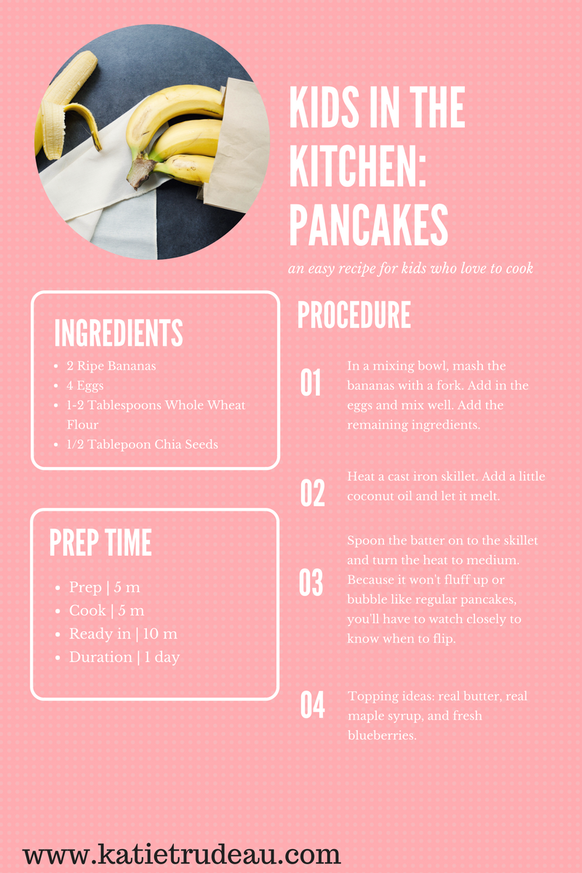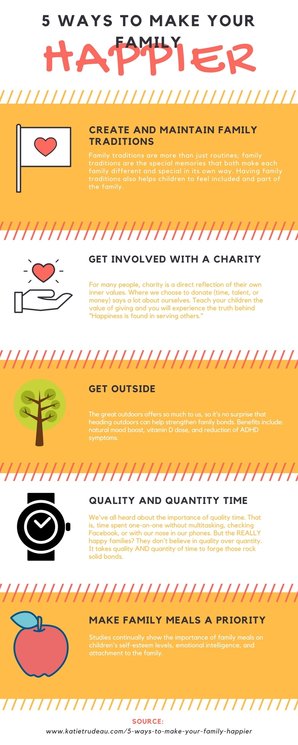5 Tips for Using Cooking as a Way to Bond with Your Kids (Plus, An Energizing Pancake Recipe)3/29/2017 It's tempting to try to rush through meal prep in order to get food on the table. I get it. I know dinner (or lunch or breakfast) can be stressful. (Read this post for reducing meal time stress.) We all know that eating together is important but actually cooking together can be an opportunity for bonding too! If you can slow down (just a little bit) and invite your kids into the kitchen, you not only get a chance to chat, but you have a valuable teaching opportunity to impart your culinary and nutrition wisdom on your kids. The key is to start simple. Use a simple recipe and hand over the reigns. The recipe above is easy and even my littles can do almost the entire recipe without help. Tips for using cooking as a bonding tool
Easy banana pancakes recipe What you need:
Do your kids help out in the kitchen? How do you use food and cooking as a bonding tool? What are your favorite recipes to cook with your kids? Comment below! This site contains affiliate links to products. We may receive a commission for purchases made through these links at no additional cost to you. We only suggest products we love and use.
0 Comments
How to Simplify Your Life to Focus on FamilyGuest post by Wendy Rouse Rohin // Wendy is a mother and Pediatric Physical Therapist with a doctoral degree and over 10 years of experience working with preemies, infants and older children with all different abilities. She absolutely love working with babies and is passionate about helping new moms and dads not only survive but THRIVE during baby's first year and beyond! You can email her, find her on Facebook, or learn more at EverythingBabies.org. This post originally appeared on EverythingBabies.org. Parenting in the modern world is unnecessarily cluttered with distractions and multitasking. Unfortunately–despite all the current advances and technology of our time–no one has yet to invent the SuperMom pill. (Don’t worry, I’m working on it.) So, in the meantime, you have to prioritize with intention, or the important things (people) will become neglected and…well…less important. Please, read on if you interested in some ideas on how to simplify your life and focus on family. Now, don’t get me wrong…it’s definitely a work in progress, not a level of achievement. (Once again, there will be no trophy or medal ceremony for this act of parental amazingness. Sorry.) Almost every day, I set my intentions and work very hard to keep my life as simple as possible, filling it with only what is loved or needed. But it’s still hard, sometimes, and I have to struggle to keep my focus and priorities on what is most important–my family. “So what do you suggest we do, EB?” Here are some ideas I’ve implemented to be the most intentional–and the least distracted– mom I can be, so I can focus on family. I don’t feel like I’ll ever arrive at complete success in this category…because I am imperfectly human, after all. I give you, dear readers, permission to set the bar really low as you start off on your personal quest. (You’re welcome.) How to Simplify Your Life so you can Focus on Family: 5 Great Tips 1. Make a list of your top priorities. You may want to review or edit your list often, every day if necessary. My priority list is titled “Focus on Family”. Then I have daily To-Do lists in order of priority. My lists are in the “notes” section of my iPhone, which syncs with my apple computer. I usually have one other the other within my reach at all times. Other people do it differently, but you must write it down and keep your lists with you wherever you go. Do you have a hard time saying “no” or put others before you and your family? (This is you if you have a nurturer, giver, people pleaser or empathic personality.) You may want to start with a less specific to-do list or wish list that you keep on your phone or planner, then make the priority list every day to keep your daily routine focused and simplified. I try to work on a daily list at bedtime, so I can go to sleep knowing my intentions are set for the next day. Sometimes I do it on a lazy, weekend morning when I’m not in a time crunch and I can plan ahead. I don’t know about you all, but I am much more productive when I’m busy. And I lost at least half of my memory and thinking skills when my daughter was born. (It’s a terminal illness every parent has to live with, I know.) So, the fleeting thought of “Well…hmmm…I don’t really have to do anything… right now…” actually sets off a ping of anxiety in my stomach. I must be forgetting something really important! (Hence, the lists.) 2. Spend money wisely. Stick to your budget! Prioritize–and be very intentional about–your purchases. Ask yourself, “Is this something we really need? Do we already have something that serves the same purpose? Will this make my life more simple? Will this help me focus on my family?” I almost always regret impulse buys and material purchases that aren’t fulfilling . Do I really need another cute skirt in my closet with the tags on it? I definitely don’t need a new sparkly iPhone case that won’t really protect my phone when I already bought a $90 Lifeproof case that is working quite well. I’m terrible about returning things, so they sit around the house, reminding me of my bad decisions. And if I just keep on driving past that yummy taco shop (eyes forward!), we can save family time, money and calories eating at home, together. I could write a lot more about spending money with intention, but I want you, dear readers, to implement this concept in ways that resonate with you. If you are focused on family and keeping your life simple, you may find that it’s not that hard to pass up on a lot of unfulfilling and unnecessary purchases. 3. Be more efficient. A.K.A– “Don’t waste your precious time”. Busy parents barely have time every day for the necessary tasks, why crazify (yep, my new word–do you like it?) your day even more with inefficiencies? Leaving the house to run only one errand? Stopping at a fast-food joint when you are on your way home from the grocery store? Playing CandyCrush for 45 minutes straight at your daughter’s therapy appointment? Scandalous! Do we really need to see everything that everyone is doing every day on Facebook? Just because you want to stay in touch with 300 of your best friends from childhood or college, doesn’t mean they all have to be on your news feed. You can just click over to their page when you are thinking about them, right? That’s easy enough. I’m guessing about 95-99% of the posts on my news feed are not more important or more meaningful that the parts of my life I’m neglecting when I’m mindlessly scrolling through. Now don’t get me wrong. We all need some brainless distractions to maintain a barely functional level of sanity. But our “mental breaks” on social distractions are actually complicating our lives and minds with unnecessary clutter, making it harder to focus on what’s really important. Have you ever tried to decrease your data plan for a month or “unplug” your social media sources for a day? You’d be surprised how much more time you have. If that’s sounds totally impossible to you, would you try setting a timer to limit your time on Facebook or Pinterest? Your kids may even notice how much more attention they are getting from you. (Attention=less whining, right?) You significant other might even notice how much more relaxed you are by the end of the day. Make sure you have your list of priorities handy to keep you from feeling bored (Ha!) or anxious. 4. Purge the unnecessaries. This applies to not only material items, but activities, habits, and people who don’t mesh with your intention to simplify your life and focus on family. Learn to say “no” if something is asked of you that doesn’t fit this purpose. You may find that you have more time and energy to say “yes” to more things that bring you happiness, like quality time with your family, or doing something for yourself. (Totally foreign concept, I know.) Appreciate what you have. Get rid of what you don’t need. Clutter and baggage contribute to your underlying stress and anxiety, even though you don’t really consciously “see it.” Don’t focus on what you think you need or want. You might be surprised what you can cross off your To-Do or wish list using this frame of mind. 5.Breathe and listen. Conscious, intentional deep breathing can really help you recharge and maintain the energy and focus you need to get through the day. It only takes ten breaths in through your nose, filling up your belly (not your chest) to reset your body’s resting, relaxed state. With 10 intentional diaphragmatic (belly) breaths, you can lower your heart rate, blood pressure, stress levels, anxiety, and pain, to name a few. Try this while trying to fall asleep, sitting at a stop light, or on the toilet, (because sometimes that’s the only free time we can get, right?). When you have a little more time, go outside, sit or lay comfortably and close your eyes. Pay attention to the sounds and sensations surrounding you, that you normally wouldn’t even notice. Listen to the birds and leaves in the trees. Feel the air on your skin and your breath inside your nose. Let your muscles melt into the surface with each exhale….. Hey! Wake up!! That’s all for now. It’s time for me to find something healthy for dinner. I hope this post at least jump starts your intention to simplify your life so you can focus on your family. Thanks so much for reading! Do you have some other suggestions? I could use some fresh ideas and old reminders, myself. It’s easy to let life get ahead of us, but it’s not too hard to reel it back in! Share your thoughts below! Love this article? Let Wendy know!
|
| About the sleep expert: Pediatric Sleep Consultant Pachi Parra has been working with children and parents for the last 3 years as a professional nanny. Seeing how many sleepless families are out there, she decided to take her childcare career to a new level; with a gentle and simple approach, she teaches their children to sleep well. Pachi was personally trained by Dana Obleman, the creator of The Sleep Sense TM Program, whose methods have been used worldwide by more than 30,000 families to solve their children's sleep problems. This program stresses the importance of teaching the children how to soothe themselves into a deep, restful sleep. Her goal is to help families to be happier and healthier one sleep at time, educating and empowering parents in the best ways to guide their children into good sleep habits. |
About Katie
Wife & Mama with a passion for peaceful parenting, natural living, homeschooling... and my daily café au lait.
Archives
July 2020
June 2020
February 2020
January 2020
September 2019
August 2019
February 2019
January 2019
October 2018
February 2018
January 2018
December 2017
June 2017
May 2017
March 2017
February 2017
January 2017
December 2016
October 2016
May 2016
April 2016
March 2016
Categories
All
100 Days
30 Day Letter Challenge
Attachment Parenting
Babywearing
Book Reviews
Books
Essential Oils
Fatherhood
Freedom Journal
Guest Post
Homeschool
Life
Marriage
Motherhood
Motivational
Parenthood
Peaceful Parenting
Real Food
Recipes
Toddler Life










